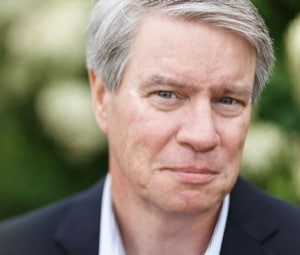

I like problem-solving at a high level, collaborating with TE engineers and other experts to seek out multiple solutions to a problem whenever possible.
Nathan Tracy studied engineering at the University of Massachusetts, North Dartmouth. His results-based, entrepreneurial spirit then took him to the southwest of the U.S. There he worked face-to-face with customers, learning lessons about problem solving, and discovered he preferred business development to design work. He joined M/A-COM (formerly part of TE) right out of school, and worked a rotational assignment that included almost every job — from factory work to field sales (where he called on customers including defense contractors), to product development. An intriguing opportunity with TE brought him to Pennsylvania “just for a few years.” Seventeen years later, Nathan’s leadership in industry standards gives him the opportunities he has always sought as a problem solver and innovator. “With TE’s resources, and access to engineers across multiple disciplines, our team is finding the solutions our customers need. It’s right where I want to be.”
In addition to the work you do in industry standards for TE, what is your role as technologist for the systems architecture team?
I focus on connectivity products used in a broad range of applications in the data communications, data center, and wireless markets. My expertise is in the physics of reliable interconnects, communication system architectures, fiber optics, high-speed signal integrity, and radio frequency (RF) systems.
How do you stay current with emerging technologies and shifting requirements?
It’s a challenge when the rate of change keeps accelerating! We can’t slow down, so I make it an even bigger priority to stay close to the customer and absorb the deluge of new information. I gain a lot of information from the industry standards meetings — that’s a great place to have a cup of coffee with system architecture experts from our customers and silicon chip developers and hear about the interests of the forward thinkers.
What present trends have the potential to influence engineering over time? Why?
Ethernet for cars! Cars are becoming more of a business tool and entertainment hub than just a travel method. Connected to data, we conduct business in the car, entertain our children in the car, and count on our safety systems, like lane warning or braking power, to have first priority on the car’s data network.
Can you tell me more about data access trends and what these trends means to us?
Consider fitness and health screening data as an example. I now have access to about five years of health screening data, and am wearing a fitness monitor with access to all this data and feedback. For me, it means being able to more proactively maintain my fitness level. That’s not only healthy, but with any luck, I will also save money in health care costs!
Do you interact regularly with other areas of the company?
The way everything is so connected today — your phone to your car to the heating system in your house — I make every opportunity to connect with other groups to exchange technology ideas and build on those ideas to come up with even greater solutions. Also, our internal TE technology conference is a great place to do this less formally.
How do you use project lessons you have learned to influence future performance?
Sometime we learn, and sometimes we repeat! I try to objectively understand what has worked well for us and what could we have done better on each project so we can improve our strengths and minimize our mistakes.
What can you tell me about a recent breakthrough discovery?
We were exploring ideas for higher density IO interconnects. Our goals were not that profound — it had to be smaller with more contacts. We wondered, “can we also increase the data rate? and if we do that, how do we solve thermal problems that will come with higher data rates and higher density?” TE’s engineers came up with the microQSFP technology concept that led to the OSFP 400 Gbps form factor, which TE is now expanding to 800 Gbps based on 100 Gbps electrical channel capabilities. This pluggable form factor enables higher density, higher aggregate bandwidth and fully integrated thermal management. TE also offers OSFP direct attach copper cables for OSFP that allows optimization of reach in a fully passive electrical interconnect.
Do you have a favorite product?
I have always been enamored with the solderless crimp-on connectors, like FASTON connectors. They’re simple and cool. They were first made in the 1950s, yet they’re still effective today. From a more recent perspective, products like the RJ point five miniature Ethernet connector, the Coolbit optical engine, and the STRADA Whisper backplane connector are all great examples of products that TE’s engineers have recently brought to market to address evolving needs. From the simplest features to the most complex products, I love being involved in our technology.
I grew up on a farm, and it seemed as if every day something needed to be fixed or improved. That was my first learning ground for problem-solving.
- Nathan Tracy,
- Technologist, System Architecture Team & Manager of Industry Standards



I like problem-solving at a high level, collaborating with TE engineers and other experts to seek out multiple solutions to a problem whenever possible.
Nathan Tracy studied engineering at the University of Massachusetts, North Dartmouth. His results-based, entrepreneurial spirit then took him to the southwest of the U.S. There he worked face-to-face with customers, learning lessons about problem solving, and discovered he preferred business development to design work. He joined M/A-COM (formerly part of TE) right out of school, and worked a rotational assignment that included almost every job — from factory work to field sales (where he called on customers including defense contractors), to product development. An intriguing opportunity with TE brought him to Pennsylvania “just for a few years.” Seventeen years later, Nathan’s leadership in industry standards gives him the opportunities he has always sought as a problem solver and innovator. “With TE’s resources, and access to engineers across multiple disciplines, our team is finding the solutions our customers need. It’s right where I want to be.”
In addition to the work you do in industry standards for TE, what is your role as technologist for the systems architecture team?
I focus on connectivity products used in a broad range of applications in the data communications, data center, and wireless markets. My expertise is in the physics of reliable interconnects, communication system architectures, fiber optics, high-speed signal integrity, and radio frequency (RF) systems.
How do you stay current with emerging technologies and shifting requirements?
It’s a challenge when the rate of change keeps accelerating! We can’t slow down, so I make it an even bigger priority to stay close to the customer and absorb the deluge of new information. I gain a lot of information from the industry standards meetings — that’s a great place to have a cup of coffee with system architecture experts from our customers and silicon chip developers and hear about the interests of the forward thinkers.
What present trends have the potential to influence engineering over time? Why?
Ethernet for cars! Cars are becoming more of a business tool and entertainment hub than just a travel method. Connected to data, we conduct business in the car, entertain our children in the car, and count on our safety systems, like lane warning or braking power, to have first priority on the car’s data network.
Can you tell me more about data access trends and what these trends means to us?
Consider fitness and health screening data as an example. I now have access to about five years of health screening data, and am wearing a fitness monitor with access to all this data and feedback. For me, it means being able to more proactively maintain my fitness level. That’s not only healthy, but with any luck, I will also save money in health care costs!
Do you interact regularly with other areas of the company?
The way everything is so connected today — your phone to your car to the heating system in your house — I make every opportunity to connect with other groups to exchange technology ideas and build on those ideas to come up with even greater solutions. Also, our internal TE technology conference is a great place to do this less formally.
How do you use project lessons you have learned to influence future performance?
Sometime we learn, and sometimes we repeat! I try to objectively understand what has worked well for us and what could we have done better on each project so we can improve our strengths and minimize our mistakes.
What can you tell me about a recent breakthrough discovery?
We were exploring ideas for higher density IO interconnects. Our goals were not that profound — it had to be smaller with more contacts. We wondered, “can we also increase the data rate? and if we do that, how do we solve thermal problems that will come with higher data rates and higher density?” TE’s engineers came up with the microQSFP technology concept that led to the OSFP 400 Gbps form factor, which TE is now expanding to 800 Gbps based on 100 Gbps electrical channel capabilities. This pluggable form factor enables higher density, higher aggregate bandwidth and fully integrated thermal management. TE also offers OSFP direct attach copper cables for OSFP that allows optimization of reach in a fully passive electrical interconnect.
Do you have a favorite product?
I have always been enamored with the solderless crimp-on connectors, like FASTON connectors. They’re simple and cool. They were first made in the 1950s, yet they’re still effective today. From a more recent perspective, products like the RJ point five miniature Ethernet connector, the Coolbit optical engine, and the STRADA Whisper backplane connector are all great examples of products that TE’s engineers have recently brought to market to address evolving needs. From the simplest features to the most complex products, I love being involved in our technology.
I grew up on a farm, and it seemed as if every day something needed to be fixed or improved. That was my first learning ground for problem-solving.
- Nathan Tracy,
- Technologist, System Architecture Team & Manager of Industry Standards



